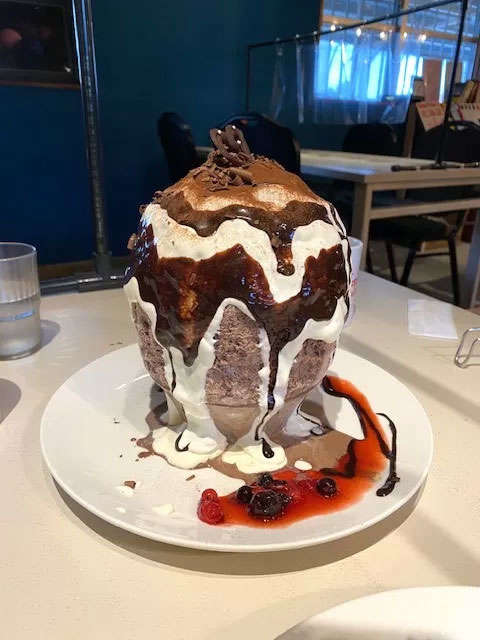
Rain can be expected on most days during this annual event, and as soon as the rainy season concludes, it turns unbearably hot and humid in many regions of Japan.
Fukuoka is especially sweltering during the summer, and one would think I would get used to it, but no chance. It always hits me with a jolt when summer finally gets underway. I prefer the autumn and winter seasons in Fukuoka because they are so pleasantly cool and comfortable.
While I come from Indiana, an area that experiences extreme heat and humidity in the summer, there is something especially oppressive about the heat and humidity one experiences during the height of a Japanese summer. It almost takes your breath away on really hot and humid days.
The upside to having such an active rainy season is how lush and green everything is in Japan after so much rain. The mountains are majestic in their foliage and the plants and trees just radiate a gorgeous natural green color.
For this column, though, I thought I would opine about the wonderful variety of summer foods that are enjoyed throughout Japan during the summer season. Most are eaten as a way to cool down during the hottest months of the summer, and all contain that lovely “umami” that Japan is so well-known for around the world.
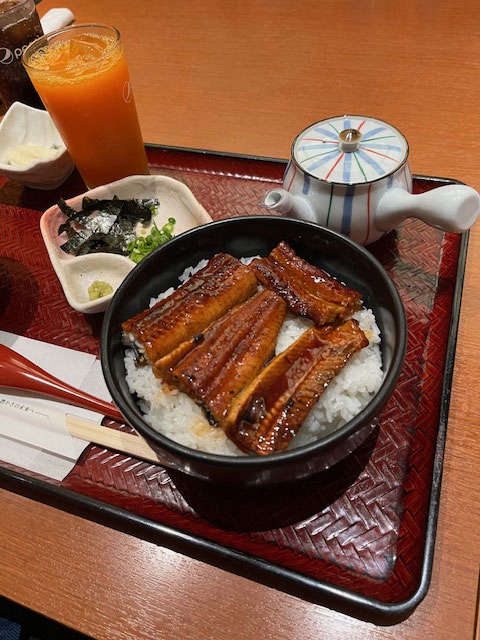
One very popular summer dish that is gobbled down throughout the summer is “unagi” (freshwater eel) (photo). It is believed that eel will help boost one’s energy levels during the dog days of summer. It is a delicacy, though, and not cheap to eat, but it is one of those very established summer dishes that most people try to splurge on as a guilty pleasure at least once during the hottest days of summer.
Sadly, I am not a fan. The first time I ate it was in 1979 when a Buddhist priest came to my host family’s home to pray during the O-Bon holiday (when the dead ancestors return to the family home for a visit). Because he was invited to dine with us, my host mother made sure she had really nice foods to offer. It was delivered in beautiful lacquered boxes, fileted over a bed of rice, covered in a special sweet and salty sauce.

I was more than willing to try it, but one bite was enough. My taste buds rejected it immediately, and there was something about the texture that made it seem so chewy. Coming from land-locked Indiana, I never grew up with fresh fish or seafood, so I never developed a taste for it. This is very unfortunate because I live in a place that has some of the best fish and seafood in the world.
I have honestly tried every type of fish or seafood offered here, and I can say with all the confidence in the world that there is not one type that I remotely like or can eat willingly.
While people who love it will devour and wolf it down and ask for seconds, I make a hard pass whenever it is offered to me. Once was all it took for me.
Unagi is very rich in vitamins, minerals, and an array of other healthy nutrients, and is often eaten to increase one’s stamina from being fatigued during the hot summer days. It is often grilled over charcoal and has a very distinct aroma that will make people who love it begin to salivate.
One summer dish I do love to eat is “hiyayakko,” which is often served as a side dish with other more substantial food offerings. It is simply a block of chilled tofu that is sprinkled with several toppings like ginger, wasabi, soy sauce, and shiso (perilla leaf). This healthy, but refreshing treat is filling and because it is chilled, offers a respite from the heat.
Another summer dish I love is “reishabu.” It is somewhat a summer version of a popular winter meal called “shabu, shabu.”
“Rei” means cold in Japanese and “shabu” comes from the hot-pot dish called “shabu, shabu,” which is thinly sliced meat that is dipped in boiling water or a sauce to cook it.
Reishabu, however, is cold pork that is served with some sort of vegetable, often cold broccoli that has been cooked. Japanese people find it odd that we Americans will eat raw broccoli, carrots, etc. by dipping them with ranch dressing as an appetizer. Normally in Japan, these vegetables are always cooked or boiled.
Reishabu is served with lettuce and tomatoes, too, sometimes. Normally a savory sesame seed dressing is drizzled over it for flavor.
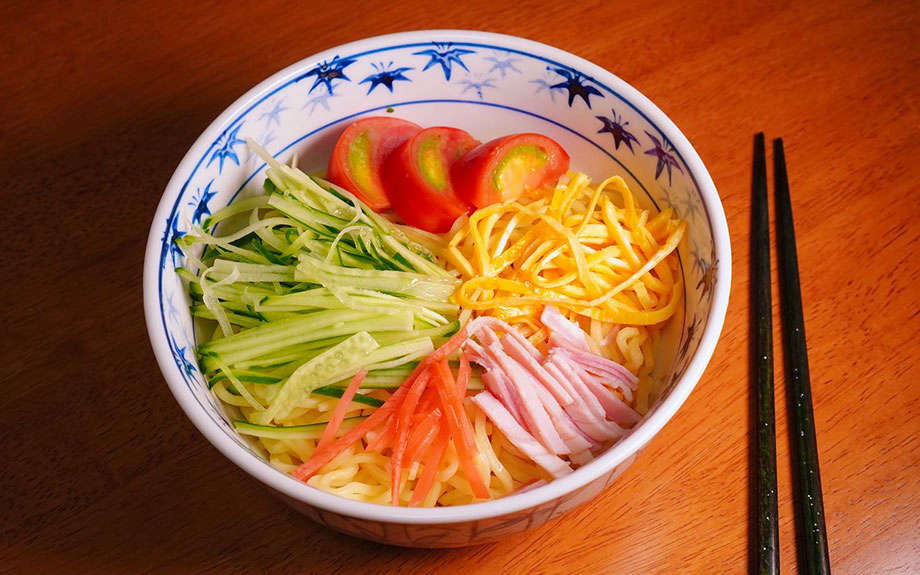
“Hiyashi chuka” is a great summer dish for ramen lovers who want to have the taste and flavor of ramen noodles without the hot soup during the summer months. This dish is a quasi-salad with ramen noodles. It is served with a variety of fresh vegetables, ham, and egg that are neatly stacked on top of and around a bed of ramen noodles (photo).
A soy sauce or sesame seed-based dressing is often served with it to add flavor. This is “ramen light” in that it isn’t as filling or as heavy as a big bowl of piping hot ramen noodles in a delicious miso or salty broth. In the summer, this dish is cooler than the hearty bowl of ramen soup that is so delicious in the winter months.
“Somen” noodles are another treat that people enjoy during the hottest days of summer. These can be found in most convenience stores during the summer season and consist of very thin noodles, boasting a very light, non-pungent flavor. After they are boiled, they are immediately put in ice water to cool them down instantly. A savory dipping sauce called “mentsuyu” is served with them, as well.
I notice students eating the convenience store versions on campus because they are so reasonably priced, making them a cheap, but cool lunch for students. During some festivals, towns will offer Nagishi somen which features noodles slithering down long bamboo shoots in running water and people have to grab the noodles quickly with chopsticks as they flow by. It makes eating somen novel and more fun.
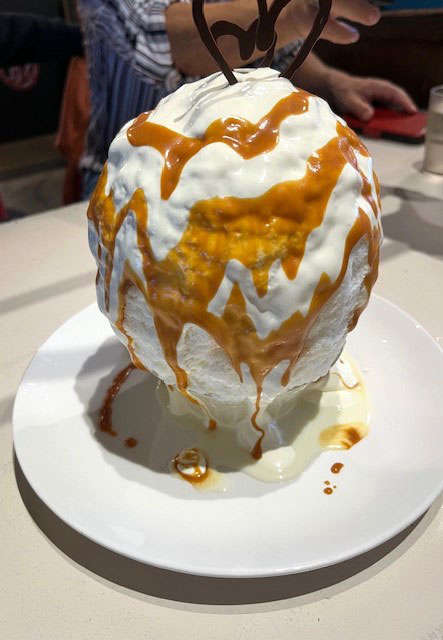
Summer in Japan is not complete without eating “kakigori” (shaved ice). It looks like our version of a snow-cone, but on steroids (photos).
Usually served in a bowl with a generous heaping pile of shaved ice, it is topped with some sort of sweet, syrupy flavoring like strawberry, vanilla cream (condensed milk), green tea, melon, or lemon. It is honestly almost a meal in itself because it is so big, but it is refreshingly delicious on a really hot day, to sit down and enjoy a big ‘ol snow-cone in a bowl!
Another summer treat in Japan, like in many countries around the world, is fresh watermelon. Adults and kids love to chow down on a huge piece of watermelon in the summer. It is a favorite dessert treat at barbecues and at beach parties.
After the main meal is finished, people will gather around several huge watermelons with big sticks and a blindfold. Those in attendance will take turns trying to whack at the one in their group to break it before the other groups succeed in order to win. This game reminds me of the popular birthday game of breaking a Mexican piñata to get the treats inside. In this game, called “suikawari,” the treat is a big chunk of watermelon to eat afterwards.
A sort of high-end summer sweet is “mizu shingen mochi wagashi.” It consists of a clear jelly in the shape of a big raindrop. Originally coming from Yamanashi Prefecture (which is one of the prefectures that surrounds Mount Fuji), but popularized in Osaka and Kyoto and then throughout all of Japan, can usually be found in expensive department stores as a summer dessert treat.
It is largely made from glutinous rice flour and lots of sugar, making it decadently sweet and delicious. Unlike most Japanese dishes, this is a relatively new addition to summer food traditions, becoming a thing around 2013-2014.
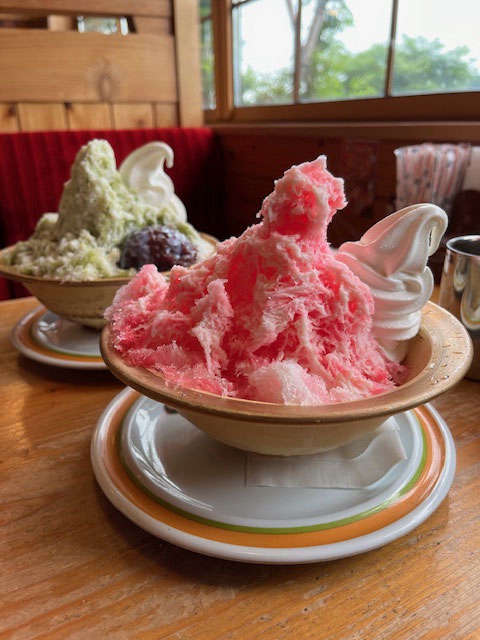
For this Hoosier, a childhood tradition and treat was to make homemade ice cream in the summer. My cousins and I would love to help with the churning of the canister and replacing the melted ice, while adding salt, as it churned. We also always had a family reunion during the summer when I was growing up and it indubitably featured delicious homemade foods that I personally associate with summer, like fruit pies, cakes, and savory foods like fried chicken and potato salad.
The summer season no matter where you hail from, offers special treats and foods that become nostalgic to all those who eat them.
Todd Jay Leonard was born and raised in Shelbyville, but has called Japan home for over 34 years. He is currently a full-professor at the University of Teacher Education Fukuoka in Kyushu where he lives, writes, and teaches. He is the author of 26 books and can be reached at toddjayleonard@yahoo.com.






